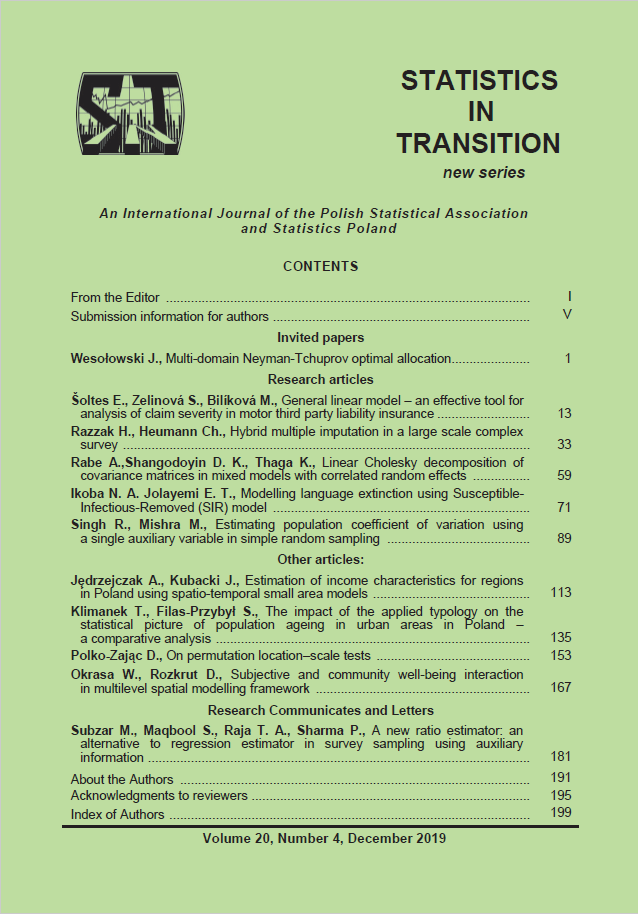ARTICLE
ABSTRACT
The aim of the paper is to review and compare the processes of population ageing in Polish urban areas. The study presents a novel approach to the problem, because in addition to measuring this phenomenon according to the National Official Register of the Territorial Division of the Country (TERYT) classification, it also measures population ageing according to the classification for urban areas (LAU 2 units) – Degree of Urbanisation (DEGURBA). Several traditional demographic measures for population ageing were applied, such as the median age, parent support ratio, ageing index, elderly dependency ratio, share of people aged 65 and older, and total dependency ratio. Also, Chu’s alternative measure of population ageing accompanied by a dynamic version of ageing index was computed. The values of these indicators for 2016 were compared with those for 2010. The authors carried out a more detailed analysis of the differences between the ageing of populations in urban areas according to the degree of urbanization (DEGURBA), and compared the outcome with the results of the TERYT-based measurement (the traditional administrative territorial division). The comparison of the outcomes of both the above-mentioned ways of measuring the phenomenon of population ageing showed discrepancies, namely the ageing process measured according to the DEGURBA typology proved to be less intensive than the same process assessed according to the TERYT typology. This indicates that there are differences between the statistical pictures of population ageing in urban areas depending on whether demographical and morfological aspects are taken into consideration or not.
KEYWORDS
TERYT classification, DEGURBA typology, urban statistics, urban ageing
REFERENCES
ABRAMOWSKA-KMON, A., (2011). O nowych miarach zaawansowania procesu starzenia się ludności, Studia Demograficzne, 1/159, pp. 3–19.
BREZZI, M., DIJKSTRA, L., RUIZ, V., (2011). OECD Extended Regional Typology: The Economic Performance of Remote Rural Regions, OECD Regional Development Working Papers, 2011/06, OECD Publishing, Paris.
CHU, C. Y. C. (1997). Age-distribution dynamics and aging indexes. Demography, 34(4), pp. 551–563.
DĄBROWSKI, A., FILAS-PRZYBYŁ, S., PAWLIKOWSKI, D., (2016). Identification of specific areas within provincial capital cities and their functional areas in terms of the demographic and economic situation of their inhabitants using GIS-based spatial analysis, Available at: http://scorus.org/index.php/conferences/2016-2/scorus-conference-in-lisbon-portugal> [Accessed 20 November 2018].
DIJKSTRA, L., POELMAN, H., (2014). A Harmonised Definition of Cities and Rural Areas: the New Degree of Urbanisation, Regional Working Paper, WP 01/2014, European Commission, Available at: https://ec.europa.eu/regional_policy/sources/docgener/work/2014_01_new_urban.pdf> [Accessed 25 November 2018].
DŁUGOSZ, Z., (1998). Próba określenia zmian starości demograficznej Polski w ujęciu przestrzennym, Wiadomości Statystyczne, No. 3, pp. 15–25.
DŁUGOSZ, Z., (2003). The level and dynamics of population ageing process on the example of demographic situation in Europe, Bulletin of Geography (socio-economic series), No. 2, Toruń: Nicolaus Copernicus University Press, pp. 5–15.
FILAS-PRZYBYŁ, S., (2012). Nowa metodologia klasyfikowania jednostek przestrzennych oparta na stopniu urbanizacji. Unpublished graduation work.
FILAS-PRZYBYŁ, S., KLIMANEK, T., KRUSZKA, K., STACHOWIAK, D., (2016). Identyfikacja obszarów specjalnych wewnątrz miast wojewódzkich – na przykładzie miasta Poznania. Available at: https://www.arcanagis.pl/identyfikacja-obszarow-specjalnych-wewnatrz-miast-wojewodzkich-na-przykladzie-miasta-poznania> [Accessed 20 November 2018].
KUREK, S., (2008). Typologia starzenia się ludności Polski w ujęciu przestrzennym, Wydawnictwo Naukowe Akademii Pedagogicznej, Prace monograficzne nr 497, Kraków.
MAJDZIŃSKA, A., (2017). Zróżnicowanie terytorialne starzenia się ludności Polski, Acta Universitatis Lodziensis Folia Oeconomica, 5(331), pp. 73–90.
NATH, D., ISLAM, M. D., (2010). New Indices: An Application of Measuring the Aging Process of Some Asian Countries with Special Reference to Bangladesh. Journal of Population Ageing, pp. 23–39.
PODOGRODZKA, M., (2016). Starzenie się ludności Polski w przekroju regionalnym, Studia Ekonomiczne. Zeszyty Naukowe Uniwersytetu Ekonomicznego w Katowicach, No. 290, pp. 83–94.
STAŃCZAK, J., SZAŁTYS, D., (2016). Regionalne zróżnicowanie procesu starzenia się ludności Polski w latach 1990–2015 oraz w perspektywie do 2040 roku, Available at: https://stat.gov.pl/download/gfx/portalinformacyjny/pl/defaultaktualnosci/5468/28/1/1/regionalne_zroznicowanie_procesu_starzenia_sie_ludnosci.pdf> [Accessed 23 December 2018].
TRZPIOT, G., OJRZYŃSKA, A., (2014). Analiza ryzyka starzenia demograficznego wybranych miast w Polsce, Studia Ekonomiczne, Zeszyty Naukowe Uniwersytetu Ekonomicznego w Katowicach, No. 178, pp. 235–249.
TRZPIOT, G., SZOŁTYSEK, J., (2015). Przemiany demograficzne a mobilność mieszkańców miast, Studia Ekonomiczne, Zeszyty Naukowe Uniwersytetu Ekonomicznego w Katowicach, No. 223, pp. 121–139.
EUROSTAT, (2011). Correspondence table Degree of Urbanisation (DEGURBA) – Local Administrative Units, Methodological notes – The New Degree of Urbanisation, Available at: http://ec.europa.eu/eurostat/ramon/miscellaneous/index.cfm?TargetUrl=DSP_DEGURBA> [Accessed 21 November 2018].
GUS, (2014). Prognoza ludności na lata 2014–2050, Availableat at: http://stat.gov.pl/download/gfx/portalinformacyjny/pl/defaultaktualnosci/5469/1/5/1/prognoza_ludnosci_na_lata____2014_-_2050.pdf> [Accessed 21 November 2018].
GUS, (2015). Identyfikacja obszarów specjalnych wewnątrz miast wojewódzkich oraz na ich obszarach funkcjonalnych uwzględniających sytuację demograficzną i ekonomiczną ich mieszkańców na podstawie analiz przestrzennych z wykorzystaniem Geographic Information System (GIS), Available at: http://stat.gov.pl/download/gfx/portalinformacyjny/pl/defaultstronaopisowa/5850/1/1/raport_obszary_specjalne_gis_1.pdf> [Accessed 20 November 2018].
GUS, (2018). Miasta w liczbach 2016, Available at: https://stat.gov.pl/download/gfx/portalinformacyjny/pl/defaultaktualnosci/5499/3/8/1/miasta_w_liczbach_2016.pdf> [Accessed 29 November 2018].
Ustawa z dnia 29 sierpnia 2003 r. o urzędowych nazwach miejscowości i obiektów fizjograficznych, Dz.U. 2003 nr 166 poz. 1612.
United Nations, Department of Economic and Social Affairs, Population Division, (2017). World Population Prospects: The 2017 Revision. New York: United Nations. ST/ESA/SER.A/399.
